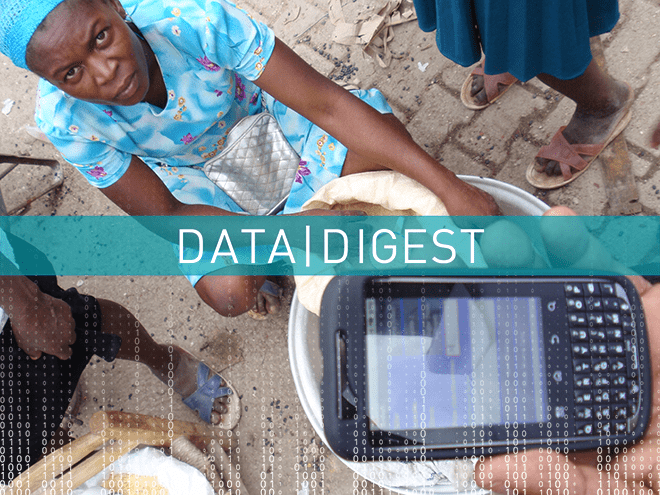
This edition of Data Digest is for the monitoring and evaluation (M&E) people out there, or monitoring, evaluation, and learning (MEL), monitoring, evaluation, research, and learning (MERL), or whatever else the cool kids are calling themselves these days! This post will focus on M&E deliverables, which are called indicators. But it will also come in handy for anyone who depends on key performance indicators (KPIs) or needs to track progress against a target.
The too long, won’t read (TL;WR) version is that we recommend a hacked version of the bullet chart and provide a link to the R package bulletchartr developed by ACDI/VOCA, so that you can use these charts in your company!
So, how should we track indicators?
For those unfamiliar with ACDI/VOCA’s work, we implement economic development projects around the world. To ensure we implement them correctly and make an impact, we set indicators that have yearly targets and track progress against these indicators.
The first problem you may run into is a lack of real-time data to monitor. If you don’t have a real-time data system, please come back once you do! As ACDI/VOCA does have a near real-time data management system, we can proceed.
The second problem is that not all indicators receive data throughout the year. A detailed schedule governs what gets collected and when, but a good amount of data comes in at the end of the year. M&E folks have several classifications for indicators, but, because we are data people, we divide them into two groups: routine indicators and yearly indicators.
By throwing away yearly indicators, we’re left with an indicator set that should be updated frequently, and thus, we can use these to figure out if we’re falling behind. That’s not to say that the yearly data isn’t important; it is the most important! But yearly data measures impact more or less—not implementation—and cannot be used for quick corrections.
The third problem is that measuring progress against a year-end target would mean that, for most of the year, the percent accomplishment is low. That’s because the year isn’t over yet, and we’re still doing stuff! A trick that can be employed is to expect that indicator accomplishment to be more or less linear.
Assuming so, if we divided the indicator accomplishment by the percent of the year elapsed, we would expect all indicators to be at 100 percent. (For example, when we are 25 percent through the year, we can assume we should be 25 percent through the target. In that case, 25 percent divided by 25 percent equals 100 percent. Make sense?)
This is a problematic assumption, especially for agricultural development projects, where project activities are not linear by design. Some indicators may require the distribution of money or inputs, which should be done early in the year, while some activities occur later in the year, perhaps right before seeding, harvest, or sales. These curves might look like this:
One way to deal with this is to assign projections and track each indicator against the projection. However, this approach isn’t without problems. We will revisit non-linearity of indicator accomplishment later, but for now, let’s ignore them and assume that indicator progression is linear. So, what is the best way to track indicators? Let’s introduce the bullet chart!
How to use a bullet chart
Stephen Few invented the bullet chart as a way to show tons of information in KPIs in a condensed form.

The bullet chart is a variation on the bar graph that has a dark bar showing an important point for that indicator, benchmark, or performance target, and other bars in the background signifying different levels of performance. The bullet chart makes it easy to compare between related measures, like presenting current status versus status at a similar time in the past. ACDI/VOCA uses them so much, we created an R package called “bulletchartr” that takes a Microsoft Excel file of indicators, their actual value, and their targets as an input, and produces a bullet chart. The different types of charts mentioned in this article can be accessed from functions in this package. For example, the above chart was produced with the function bullet_chart. We encourage you to install the package, collaborate, and bring up any issues or feature requests. To start: devtools::install_github("ACDIVOCATech/bulletchartr").
Below is the bullet chart style that ACDI/VOCA uses. You can find it in the bulletchartr package (function bullet_chart_symbols).
Ok, there’s a lot going on here, so let’s explain! As you can see, the bars show progress along the horizontal axis, presenting the percentage of the yearly target completed. The horizontal axis also shows the percent of the year elapsed with a vertical line indicating today’s exact percentage. At ACDI/VOCA, we use percentages because we have multiple indicators of varying units and parameters for each project, so normalizing against each target makes sense.
Each bar is color-coded green when the indicator is near or past the “Today” line, orange when it is close, and red when it is not close. Instead of showing a vertical tick mark on each bar, we show a constant line that progresses from zero to 100 percent of the year. However, if you prefer to show individual targets based on projects, you could easily do this by showing individual lines, as illustrated below, which can be accomplished via function bullet_chart_vline of the package.

Returning to the original chart, there are two symbols displayed in addition to the bars: a circle and a diamond. The diamond shows where we were last week, two weeks ago, or some configurable short-term indicator, and can be used to show ongoing progress. The circle shows where we were on today’s date last year, which is important because last year’s value represents a standard that takes into consideration the potential non-linearity of indicator accomplishment. In other words, you always plant the crops at the same time of year, so knowing where you are compared to last year can help you determine whether you are ahead or behind as well. This is much more transparent and efficient than comparison to projections.
We use diamond and circle symbols, instead of the additional bars typically used in a bullet chart because we think it’s easier to understand. But below is a more traditional example, using differently sized bars to compare last week and last year (function bullet_chart_wide).
This chart conforms more closely to the standard bullet chart design. The main distinction with using this design is that you must ensure each bar varies in thickness, as the benchmark for previous time points, to accentuate the difference graphically.
We’ve heard great things about this bullet chart from our field staff, who say it allows our stakeholders to take a quick glance and see which items need work and what is being worked on. We hope it’s as useful to you!
Many thanks to Ryo Nakagawara, our data analytics and visualization intern, who coauthored this post.






